Earth’s only natural satellite, the Moon, holds a dual role in our lives. It’s both a physical celestial body and a powerful symbol in tarot. Its gravitational pull shapes tides, while its phases inspire cycles of intuition and shadow work.
With a diameter of 3,474 km, this satellite orbits our planet at an average distance of 384,399 km. Tidal locking ensures one side always faces Earth, mirroring the tarot’s theme of hidden truths. The lunar surface experiences extreme temperatures, ranging from -173°C to 127°C, reflecting emotional highs and lows.
Maria formations, the dark areas on the lunar surface, symbolize the tarot’s shadow symbolism. Recent discoveries suggest remnants of Theia, a planet that collided with Earth billions of years ago, may lie in our mantle. This connection deepens the Moon’s mystique.
As the fifth-largest moon in the solar system, it influences both science and spirituality. Its synodic month, lasting 29.5 days, aligns with tarot’s illusion themes. Whether gazing at a full moon or drawing the Moon card, its mysteries invite exploration.
Key Takeaways
- Earth’s only natural satellite influences both science and spirituality.
- Tidal locking keeps one side of the Moon permanently hidden.
- Extreme temperatures on the lunar surface reflect emotional highs and lows.
- Maria formations symbolize the tarot’s shadow symbolism.
- The synodic month aligns with tarot’s themes of intuition and illusion.
The Moon in Tarot: Symbolism and Mystical Meaning
In tarot, the Moon card symbolizes the journey through shadows and illusions. Its imagery often features a crawfish climbing toward a moonlit path, representing the ascent from subconscious fears to higher awareness. This card invites us to explore the hidden truths within ourselves.

Decoding the Moon Card’s Visual Language
The Moon card’s visuals are rich with meaning. The lunar surface, with its maria and ray systems, mirrors the card’s themes of hidden depths and unexpected impacts. Just as craters tell stories of cosmic collisions, the card reflects life’s sudden challenges and transformations.
Flowing water in the card’s imagery connects to ancient lunar magma oceans, symbolizing emotional undercurrents. The dog and wolf represent the internal conflict between instinct and compassion, a duality central to shadow work.
Shadow Work and Lunar Illusions in Divination
Shadow work is a key aspect of the Moon card. Carl Jung’s concept of the shadow side aligns with the card’s call to acknowledge repressed fears and desires. By confronting these hidden aspects, we can achieve emotional balance and growth.
The Moon’s phases mirror cycles of intuitive development. Just as the full moon illuminates the night, this card encourages us to shine light on our subconscious patterns. Apollo 16’s discoveries in the Cayley Formation remind us that even hidden truths can be uncovered with time and effort.
Scientific Facts About Earth’s Moon
Our closest celestial neighbor plays a vital role in both science and Earth’s stability. Its gravitational pull shapes tides, while its orbit ensures a balanced climate. Let’s explore the fascinating details that make this satellite a cornerstone of our solar system.
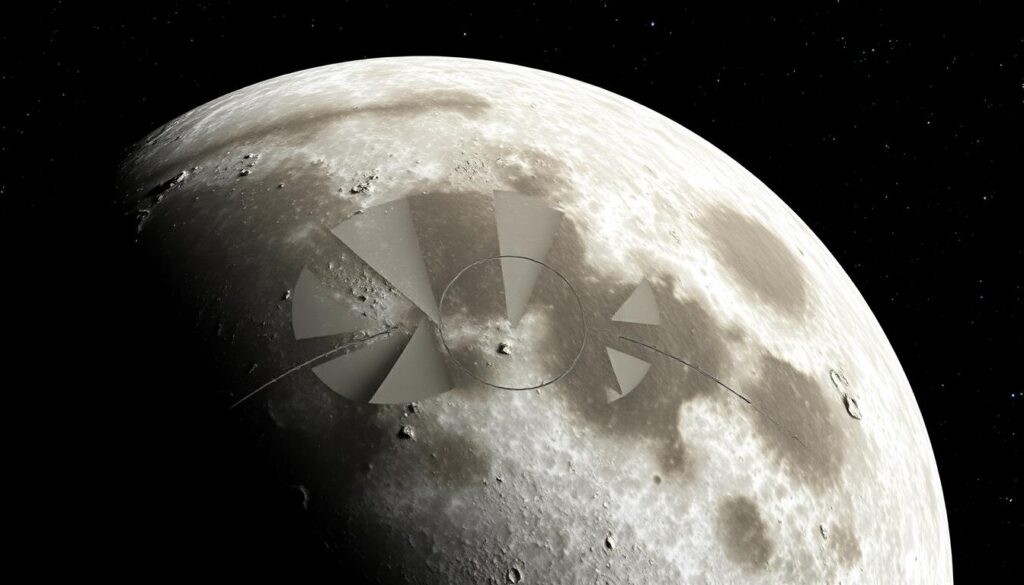
Basic Lunar Statistics and Measurements
This natural satellite has a mass of 7.346×10²² kg, about 1.2% of Earth’s. Its circumference measures 10,921 km, and it orbits at a speed of 1.022 km/s. With an axial tilt of 23.5°, it helps stabilize Earth’s climate, reducing extreme weather fluctuations.
Its surface gravity is 1.622 m/s², roughly one-sixth of Earth’s. The escape velocity is 2.38 km/s, much lower than our planet’s 11.2 km/s. These measurements highlight its unique place in the solar system.
The Moon’s Role in Earth’s Stability
This satellite’s gravitational pull creates tides, influencing ocean currents and marine ecosystems. Its axial tilt stabilization prevents drastic climate shifts, making Earth more habitable. Without it, our planet’s environment would be far less stable.
Its recession rate of 3.8 cm per year, measured using Apollo retroreflectors, shows it’s slowly moving away. This gradual drift has shaped Earth’s history and will continue to influence its future.
From its formation billions of years ago to its current orbit, this celestial body remains a marvel of science and a key player in Earth’s story.
Formation of The Moon: Cosmic Origins
Billions of years ago, a cosmic collision shaped the destiny of our planet and its companion. This event, known as the Giant Impact Hypothesis, remains the most widely accepted explanation for the Moon’s formation. Let’s explore the science behind this fascinating theory and the evidence that supports it.
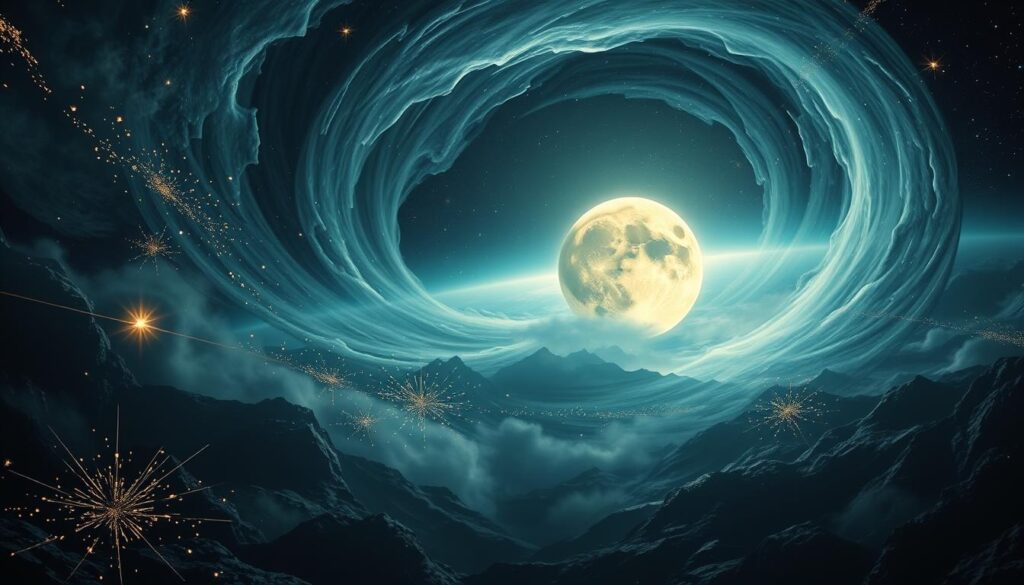
The Giant Impact Hypothesis
Around 4.5 billion years ago, a Mars-sized body named Theia collided with Earth. The impact ejected debris into space, which eventually coalesced to form the Moon. This theory explains the similarities in oxygen isotope ratios between lunar samples and Earth’s crust.
Recent simulations suggest remnants of Theia may still exist within Earth’s mantle. This discovery strengthens the hypothesis, offering a glimpse into the early solar system’s chaotic environment.
Alternative Formation Theories
While the Giant Impact Hypothesis is dominant, other theories have been proposed. The fission theory suggests the Moon split from Earth due to rapid rotation. However, the Moon’s high moment of inertia contradicts this idea.
The co-formation theory posits that Earth and its satellite formed together. Yet, angular momentum calculations challenge this explanation. Each theory highlights the complexity of understanding the Moon’s origins.
Geochemical Evidence From Lunar Samples
Lunar samples collected during Apollo missions provide critical insights. Anorthosite rocks, similar to Earth’s crust, support the impact theory. Titanium isotopes in Apollo 14 breccias further confirm the Moon’s connection to Earth.
Zircon crystals dated to 4.4 billion years reveal the Moon’s ancient history. These findings, combined with magma ocean crystallization studies, paint a detailed picture of its formation.
Physical Characteristics of Our Moon
Exploring the physical traits of Earth’s satellite reveals fascinating details about its structure and behavior. From its core to its surface, this celestial body holds secrets that shape its interactions with our planet and the solar system.
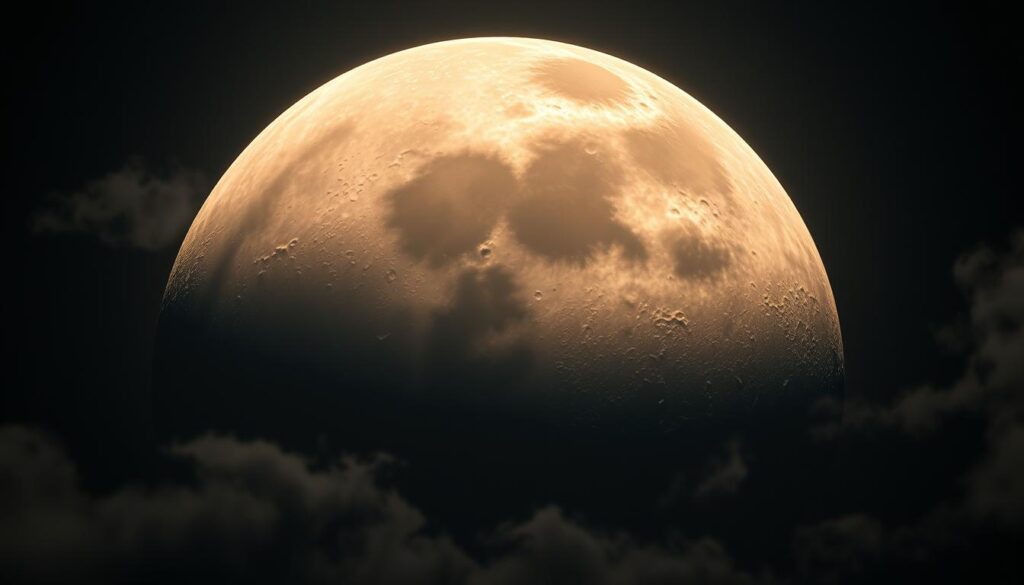
Size and Mass Comparisons
With a radius of about 1,080 miles, this satellite is roughly one-fourth the size of Earth. Its mass, at 0.0735 × 10²⁴ kg, is just 1.2% of our planet’s. Despite its smaller size, its gravitational pull significantly influences Earth’s tides and climate.
Internal Structure and Composition
Beneath the lunar surface lies a core with a radius of 240-330 km. Apollo seismic data suggests a partially molten outer core and a solid inner core. The crust varies in thickness, with maria regions measuring 5-15 km and highlands reaching up to 60 km.
SELENE radar findings reveal a mantle discontinuity, indicating complex internal dynamics. These layers, formed billions of years ago, provide clues about its origins and evolution.
Gravitational Peculiarities
Mascons, or mass concentrations, alter spacecraft orbits due to uneven gravitational fields. The GRAIL mission mapped these anomalies, revealing a fossil bulge from its early orbital proximity to Earth. Its moment of inertia factor, 0.3929, is unique among terrestrial planets.
Magnetic Field Mysteries
Unlike Earth, this satellite lacks a global magnetic field. However, remanent magnetism in the highlands suggests it once had a stronger field. This phenomenon, thousands of times weaker than Earth’s, remains a puzzle for scientists.
From its core to its surface, this celestial body continues to captivate researchers and enthusiasts alike. Its physical characteristics not only define its role in the solar system but also deepen our understanding of space and planetary science.
The Moon’s Orbit and Rotation
Understanding the dynamics of Earth’s companion reveals its intricate relationship with our planet. Its orbit and rotation are key to its influence on tides and climate. Let’s explore how these movements shape its behavior.

Tidal Locking Explained
Tidal locking ensures one side always faces Earth. This phenomenon occurs due to gravitational pull, which slows the satellite’s rotation over time. As a result, it takes the same amount of time to rotate on its axis as it does to complete one orbit.
This synchronization creates the familiar “near side” and “far side.” It’s a fascinating example of how celestial mechanics shape our view of space.
Orbital Eccentricity and Variations
The orbit isn’t a perfect circle. With an eccentricity of 0.0549, it’s slightly elliptical. This causes variations in distance, ranging from 363,300 km at perigee to 405,507 km at apogee.
These changes influence tides and gravitational interactions. Over years, the earth moon system evolves, with the satellite slowly moving away at 38 mm per year.
| Orbital Parameter | Value |
|---|---|
| Eccentricity | 0.0549 |
| Sidereal Period | 27.3 days |
| Nodal Precession Cycle | 18.6 years |
| Average Distance | 238,900 miles |
Lunar Surface Features
Exploring the lunar surface reveals a landscape shaped by ancient forces and cosmic events. From towering highlands to vast plains, this celestial body showcases a unique blend of geological wonders. Let’s dive into its most striking features.
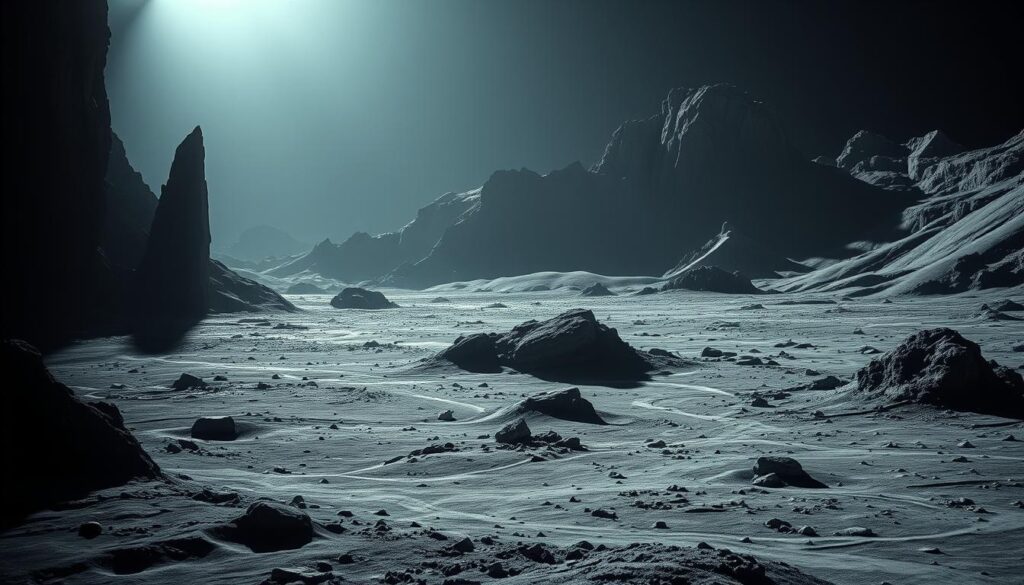
Highlands vs Maria: The Two Faces
The lunar surface is divided into two distinct regions: the bright, rugged highlands and the dark, smooth maria. Highlands, composed of feldspathic rocks, cover 83% of the surface. They are heavily cratered, showcasing billions of years of impacts.
Maria, on the other hand, are vast basaltic plains formed by ancient volcanic activity. Covering 17% of the surface, they are mostly found on the near side. Mare Tranquillitatis, spanning 873 km, is a prime example of these dark, solidified lava flows.
Impact Craters and Their Stories
Impact craters dominate the lunar landscape, ranging from small pits to massive basins. The South Pole-Aitken Basin, with a depth of 13 km, is one of the largest and oldest. Its formation tells a story of a colossal cosmic collision billions of years ago.
Smaller craters, like Catena Littrow, provide insights into the frequency and intensity of meteorite impacts. These features, preserved due to the lack of atmosphere and water, serve as a record of the solar system’s history.
Volcanic History and Basalt Plains
Volcanic activity has left its mark on the lunar surface. Sinuous rilles, such as Vallis Schröteri, stretch over 160 km and were formed by ancient lava flows. These channels, around 500 meters deep, highlight the Moon’s dynamic past.
Basalt plains, like Mare Nectaris, are remnants of volcanic eruptions that occurred 4 billion years ago. Chang’e-5’s recent samples from Oceanus Procellarum revealed basalts as young as 1.2 billion years, offering new insights into lunar volcanic history.
The Moon’s Atmosphere (Or Lack Thereof)
Unlike Earth, this celestial body lacks a dense atmosphere, making its surface unique in the solar system. Its exosphere is so thin that it’s often considered nonexistent. Surface pressure during the day is a mere 10⁻⁷ Pa, dropping even lower at night.

Apollo 17’s Cold Cathode Gauge provided critical measurements of this near-vacuum environment. These missions revealed that the exosphere consists of trace gases like helium, argon, and sodium. Surveyor 7’s observations of lunar horizon glow further highlighted the presence of dust particles suspended above the surface.
Electrostatic dust transport is a key mechanism in this environment. Charged particles from the surface are lifted by electrostatic forces, creating a dynamic, if sparse, exosphere. This process is similar to what occurs on Mercury, though the lunar exosphere is even thinner.
The Lunar Atmosphere and Dust Environment Explorer (LADEE) mission provided groundbreaking insights. It detected sodium and potassium in the exosphere and mapped dust distribution. LADEE’s findings also shed light on argon-40 release from KREEP regions, offering clues about the satellite’s internal activity.
Solar wind sputtering plays a significant role in shaping the exosphere. Charged particles from the Sun bombard the surface, releasing atoms and molecules into space. This continuous process has shaped the lunar environment for billions of years.
From Apollo’s early measurements to LADEE’s advanced data, our understanding of this celestial body’s atmosphere has evolved. Its near-vacuum state remains a fascinating subject for scientists and space enthusiasts alike.
Water on the Moon: Surprising Discoveries
Recent discoveries have revealed that water exists in unexpected places on the lunar surface. This finding has transformed our understanding of Earth’s companion and its potential for future exploration. From polar ice deposits to hydration across the surface, these revelations are reshaping scientific priorities.
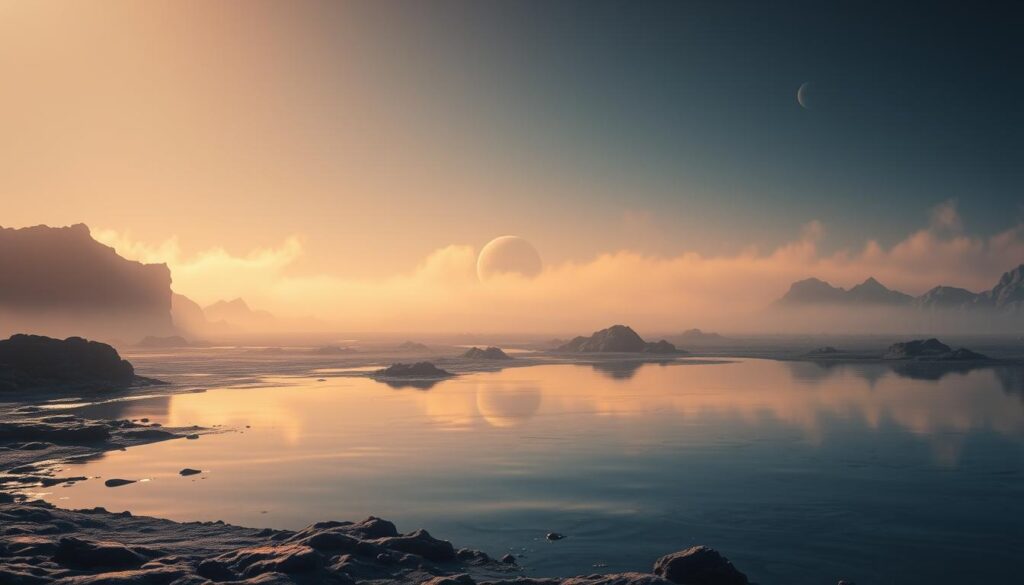
Polar Ice Deposits
Permanently shadowed regions at the poles are home to significant ice deposits. The LCROSS mission detected 5.6% water ice in these areas, confirming their potential as resources for future missions. Mini-RF radar data has further mapped these deposits, providing detailed insights into their distribution.
Neutron spectrometers have also played a crucial role. These instruments detect hydrogen, a key indicator of water presence. Findings from the Lunar Reconnaissance Orbiter (LRO) show that ice is concentrated in craters that never receive sunlight.
Hydration Across the Surface
Hydration isn’t limited to the poles. SOFIA’s observations revealed 100-400 ppm of water molecules in Clavius Crater, a sunlit region. This discovery suggests that water may be more widespread than previously thought.
Chang’e-5’s in situ detection of water on the surface adds to this evidence. The mission’s findings highlight the diurnal hydration cycle, where water molecules form and dissipate with temperature changes. This cycle is critical for understanding how water persists in such a harsh environment.
Volcanic outgassing is another potential source. Models suggest that ancient eruptions may have delivered water to the surface, where it became trapped in minerals. These processes, combined with impact events, have created a complex water distribution system.
Artemis missions are now focusing on extracting this water for human use. Technologies like ice mining and water purification are being developed to support long-term lunar exploration. These efforts could turn the Moon into a stepping stone for deeper space missions.
Human Exploration of The Moon
From historic landings to modern robotics, lunar exploration has evolved dramatically over decades. These efforts have deepened our understanding of Earth’s closest celestial neighbor and paved the way for future discoveries.

Historic Apollo Missions
The Apollo program marked a monumental leap in space exploration. Apollo 17, the final mission, included a 75-hour surface stay. Astronauts conducted extensive geological studies, using a Lunar Roving Vehicle to explore the Taurus-Littrow valley.
Apollo missions also deployed the Apollo Lunar Surface Experiments Package (ALSEP). These instruments measured moonquakes, surface temperature, and other environmental factors. ALSEP’s legacy continues to inform lunar science today.
Modern Robotic Explorers
Robotic missions have taken center stage in recent years. The Lunar Reconnaissance Orbiter (LRO) has been mapping the surface since 2009. Its high-resolution imaging, at 1 meter per pixel, helps identify potential landing sites and resources.
Chandrayaan-3, India’s 2023 mission, successfully soft-landed on the surface. It demonstrated advancements in autonomous landing systems and rover operations. Similarly, Chang’e-6 aims to collect samples from the far side, highlighting progress in far-side exploration.
- Luna 16 vs Apollo: Luna 16 used an automated drill for sample return, while Apollo missions involved astronauts manually collecting samples.
- ALSEP Experiments: These packages provided critical data on seismic activity and lunar atmosphere composition.
- Chandrayaan-3: Showcased improvements in landing precision and rover functionality.
- CAPSTONE: Verified the Near Rectilinear Halo Orbit (NRHO) for future lunar Gateway missions.
- Kaguya: Captured stunning HDTV observations of the lunar surface.
- Chang’e-6: Aims to return samples from the Apollo Basin, advancing far-side exploration.
- VIPER Rover: Will explore Nobile Crater, searching for water ice in permanently shadowed regions.
The Moon’s Influence on Earth
From ocean currents to biological rhythms, its impact is profound. This celestial body’s gravitational pull shapes Earth’s environment in ways both visible and subtle. Its presence has been a constant force, influencing life and natural processes for billions of years.
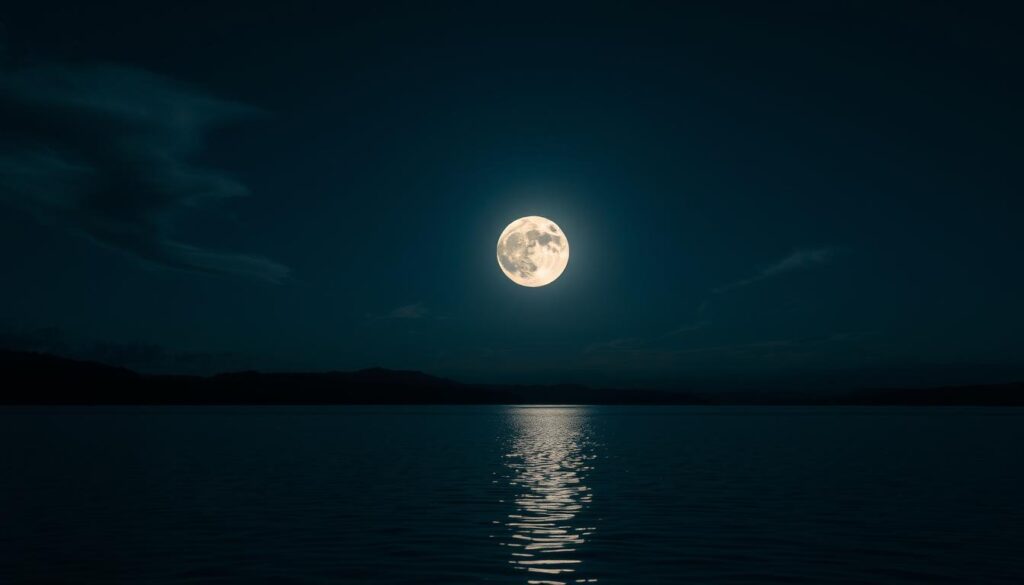
Tidal Effects and Ocean Currents
Tides are one of the most noticeable effects of its gravitational pull. The M₂ tidal constituent dominates, creating daily fluctuations in sea levels. These tidal movements drive ocean currents, which in turn affect marine ecosystems and weather patterns.
Research shows that tidal acceleration lengthens Earth’s day by 1.7 milliseconds each century. This phenomenon, known as tidal braking, is a result of energy transfer between Earth and its companion. Over time, this interaction has shaped the planet’s rotation and climate.
- Tidal dissipation in the Bering Sea affects regional ecosystems.
- Cyclostratigraphy models reveal ancient tidal patterns.
- Atmospheric tides, driven by its gravity, influence weather systems.
Lunar Cycles and Biological Rhythms
Biological rhythms are deeply tied to its cycles. Coral spawning on the Great Barrier Reef, for example, is synchronized with its phases. This event creates a stunning spectacle visible even from space.
Other species, like horseshoe crabs, use its light for navigation. Their circadian rhythms are entrained by its phases, showcasing the intricate connection between life and this celestial body. Even humans may experience subtle effects, as studies suggest a link between its cycles and sleep patterns.
“Its cycles are a silent conductor of life’s rhythms, guiding behaviors across species.”
Fossil growth rings provide evidence of past rotation rates, offering insights into how its influence has evolved. These findings highlight the enduring relationship between Earth and its companion.
| Lunar Influence | Impact |
|---|---|
| Tidal Braking | Lengthens Earth’s day by 1.7 ms/century |
| Coral Spawning | Synchronized with its phases |
| Horseshoe Crab Navigation | Uses its light for orientation |
| Atmospheric Tides | Influences weather patterns |
Cultural Significance of The Moon
For millennia, humans have looked to the night sky, finding inspiration and meaning in its luminous companion. From ancient myths to modern art, this celestial body has shaped cultures across the globe. Its phases and presence have been woven into the fabric of human history, influencing everything from religious practices to artistic expression.
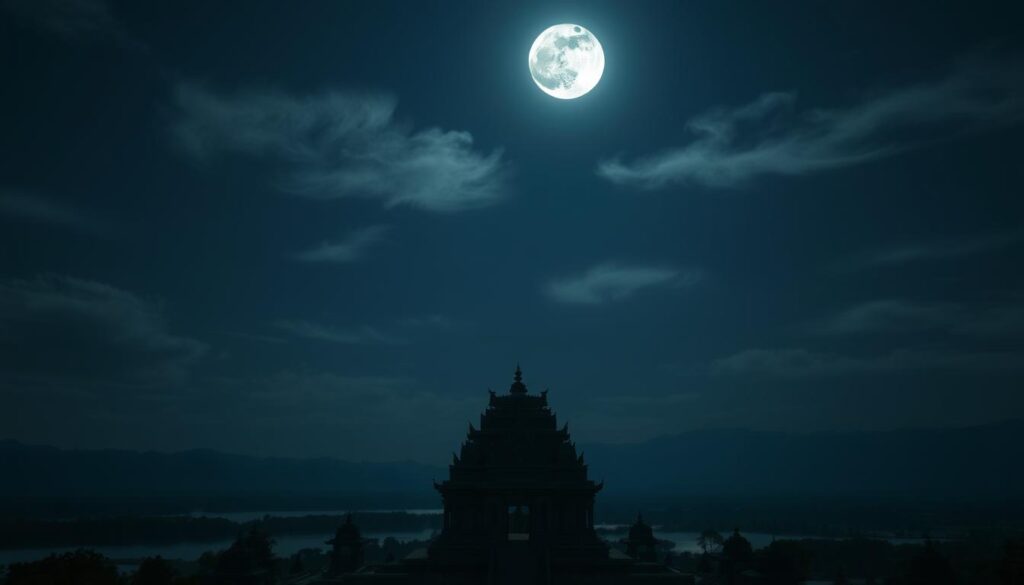
Mythology and Ancient Beliefs
Ancient civilizations often saw the Moon as a divine entity. The 5,000-year-old Knowth lunar calendar in Ireland reflects its role in timekeeping and spiritual rituals. In Babylonian culture, lunar omens in the Enuma Anu Enlil text were used to predict events, linking its cycles to earthly affairs.
Across Asia, the story of Chang’e varies but consistently highlights themes of love and sacrifice. In Egypt, the god Khonsu was depicted with a lunar disk, symbolizing guidance and protection. These myths reveal how deeply this celestial body has influenced human thought and belief systems.
The Moon in Art and Literature
Artists and writers have long been captivated by its mystique. Galileo’s detailed drawings in Sidereus Nuncius marked a turning point in scientific observation. Romantic poets like Shelley and Keats used its imagery to explore themes of beauty and melancholy.
In literature, Jules Verne’s 1865 novel From the Earth to the Moon imagined lunar exploration long before it became a reality. Modern works, such as Laurie Anderson’s VR art piece To the Moon, continue to use it as a metaphor for the human condition.
- Babylonian lunar omens shaped ancient predictions.
- Chang’e myths vary but share universal themes.
- Galileo’s drawings advanced scientific understanding.
- Romantic poetry used lunar symbolism extensively.
- Apollo missions inspired architectural designs.
- Lunar festivals like Mid-Autumn celebrate its beauty.
- Religious calendars often align with its phases.
From ancient calendars to modern art, the Moon’s cultural significance remains profound. Its influence spans space and time, connecting humans across generations. To learn more about its role in exploration, visit our page on lunar exploration.
Future of Lunar Exploration
Humanity’s next giant leap is set to take place on the lunar surface. With missions like Artemis III scheduled for 2026, the focus is on establishing a sustainable presence. The Lunar Gateway, set to begin assembly in 2028, will serve as a staging point for deeper space exploration.
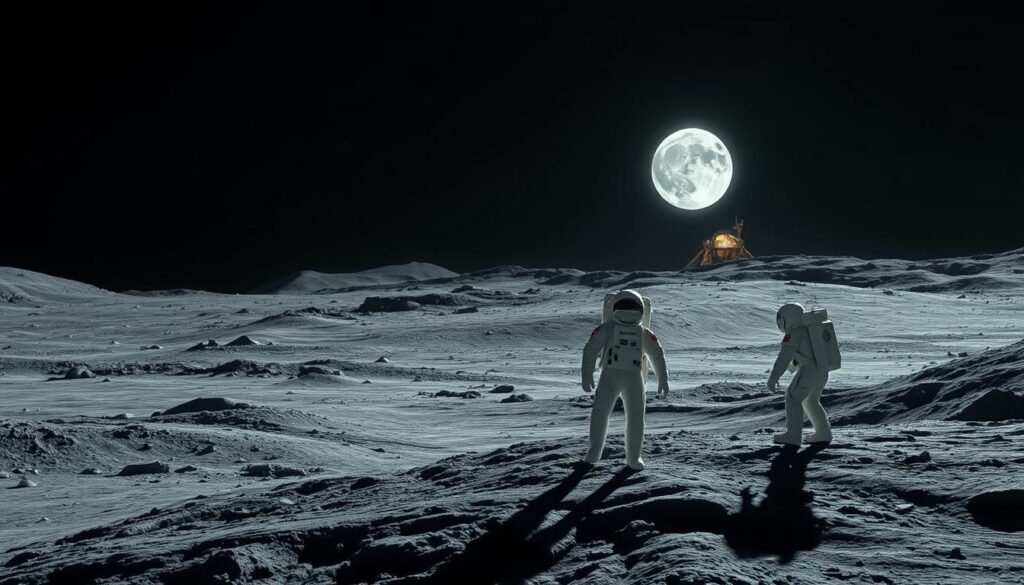
Planned Crewed Missions
Artemis III will mark the first crewed landing since Apollo. The mission will use SpaceX’s Starship HLS, designed for precision landings near the lunar south pole. This region is rich in water ice, a critical resource for future missions.
Lunar Gateway will act as a command module, supporting both crewed and robotic missions. Its modular design allows for international collaboration, with 53 countries already joining the Artemis Accords. This framework ensures safe and equitable resource sharing.
Potential for Lunar Colonization
Colonizing the Moon is no longer science fiction. The Regolith Adaptive Modification System (RAMs) is being developed to convert lunar soil into building materials. MIT’s MOXIE technology aims to extract oxygen from the lunar surface, making it habitable.
ESA’s Moon Village concept envisions a collaborative habitat, blending surface and lava tube designs. Lava tubes offer natural protection from radiation and micrometeorite impact, making them ideal for long-term settlements.
- FISO: In-situ propellant production will reduce reliance on Earth resources.
- International Treaties: Frameworks for lunar resource use are being developed.
- Lunar Reconnaissance: Ongoing studies ensure safe and efficient exploration.
From extracting water ice to building habitats, the Moon is becoming a stepping stone for humanity’s journey into the cosmos. The future of lunar exploration is bright, with innovations paving the way for a sustainable presence on our closest celestial neighbor.
Conclusion: Integrating Lunar Wisdom
Lunar wisdom bridges science and spirituality, offering insights into both cosmic and personal realms. Its phases and patterns, like maria formations, mirror life’s cycles of growth and transformation. Tidal forces remind us of nature’s rhythms, while crater formations symbolize resilience in the face of challenges.
The lunar south pole, with its unexplored potential, inspires curiosity and discovery. Balancing scientific exploration with mystical understanding allows us to fully appreciate its significance. Upcoming lunar solar eclipses provide opportunities to reflect on its profound impact on our planet and lives.
With 382kg of lunar samples returned and 108 meteorites discovered, its mysteries continue to unfold. Whether through tarot or selenochronology, integrating lunar knowledge enriches our connection to the solar system and beyond.

